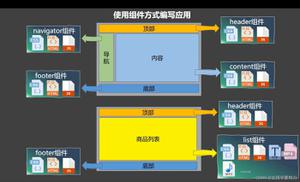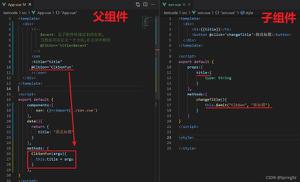vue动态子组件的实现方式

让多个组件使用同一个挂载点,并动态切换,这就是动态组件。
通过使用保留的 <component>元素,动态地绑定到它的 is 特性,可以实现动态组件。
方式一:局部注册所需组件
<div id="example"><button @click="change">切换页面</button>
<component :is="currentView"></component>
</div>
<script>var home = {template:'<div>我是主页</div>'};
var post = {template:'<div>我是提交页</div>'};
var archive = {template:'<div>我是存档页</div>'};
new Vue({
el: '#example',
components: {
home,
post,
archive,
},
data:{
index:0,
arr:['home','post','archive'],
},
computed:{
currentView(){
return this.arr[this.index];
}
},
methods:{
change(){
this.index = (++this.index)%3;
}
}
})
</script>
使用<keep-alive>缓存
<keep-alive> 包裹动态组件时,会缓存不活动的组件实例,而不是销毁它们。和 <transition>相似,<keep-alive> 是一个抽象组件:它自身不会渲染一个 DOM 元素,也不会出现在父组件链中。
基本用法:
<div id="example"><button @click="change">切换页面</button>
<keep-alive>
<component :is="currentView"></component>
</keep-alive>
</div>
条件判断
如果有多个条件性的子元素,<keep-alive> 要求同时只有一个子元素被渲染:
<div id="example"><button @click="change">切换页面</button>
<keep-alive>
<home v-if="index===0"></home>
<posts v-else-if="index===1"></posts>
<archive v-else></archive>
</keep-alive>
</div>
<script>new Vue({
el: '#example',
components:{
home:{template:`<div>我是主页</div>`},
posts:{template:`<div>我是提交页</div>`},
archive:{template:`<div>我是存档页</div>`},
},
data:{
index:0,
},
methods:{
change(){
let len = Object.keys(this.$options.components).length;
this.index = (++this.index)%len;
}
}
})
</script>
activated 和 deactivated
activated 和 deactivated 在 <keep-alive> 树内的所有嵌套组件中触发:
<div id="example"><button @click="change">切换页面</button>
<keep-alive>
<component :is="currentView" @pass-data="getData"></component>
</keep-alive>
<p>{{msg}}</p>
</div>
<script>new Vue({
el: '#example',
data:{
index:0,
msg:'',
arr:[
{
template:`<div>我是主页</div>`,
activated(){
this.$emit('pass-data','主页被添加');
},
deactivated(){
this.$emit('pass-data','主页被移除');
},
},
{template:`<div>我是提交页</div>`},
{template:`<div>我是存档页</div>`}
],
},
computed:{
currentView(){
return this.arr[this.index];
}
},
methods:{
change(){
var len = this.arr.length;
this.index = (++this.index)% len;
},
getData(value){
this.msg = value;
setTimeout(()=>{
this.msg = '';
},500)
}
}
})
</script>
include和exclude
include 和exclude属性允许组件有条件地缓存。二者都可以用逗号分隔字符串、正则表达式或一个数组来表示:
<!-- 逗号分隔字符串 --><keep-alive include="a,b">
<component :is="view"></component>
</keep-alive>
<!-- 正则表达式 (使用 v-bind) -->
<keep-alive :include="/a|b/">
<component :is="view"></component>
</keep-alive>
<!-- Array (use v-bind) -->
<keep-alive :include="['a', 'b']">
<component :is="view"></component>
</keep-alive>
匹配首先检查组件自身name选项,如果name选项不可用,则匹配它的局部注册名称(父组件 components 选项的键值)。匿名组件不能被匹配。
<keep-alive include="home,archive"><component :is="currentView"></component>
</keep-alive>
上面的代码,表示只缓存home和archive,不缓存posts
方式二:动态注册组件实现
asyncComponents(templateName){ this.curNavComponents = require(`./components/${templateName}.vue`).default;
}
参考地址:
- Vue动态组件
- vue父组件如何动态注册子组件
以上是 vue动态子组件的实现方式 的全部内容, 来源链接: utcz.com/z/380369.html







